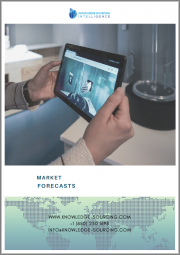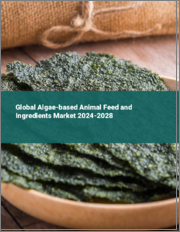
|
시장보고서
상품코드
1302951
세계의 조류 동물사료 시장 예측(2023-2028년)Algae Animal Feed Market - Forecasts from 2023 to 2028 |
||||||
세계의 조류 동물사료(Algae Animal Feed) 시장 규모는 44억 7,100만 달러에 달했스빈다. 2028년 36.56%의 CAGR로 성장할 전망이며, 395억 9,200만 달러에 이를 것으로 예측됩니다.
지속 가능한 대체 동물사료를 요구할 때 생산자는 조류 사용을 고려합니다. 말, 개, 고양이, 소, 수족관 물고기 등 많은 동물들은 조류가 고단백질이기 때문에 섭취할 수 있습니다. 조류는 장래 동물사료로 유망하지만 표준 제품으로 인정되기 위해서는 추가 연구와 개발이 필요합니다. 조류 사료에는 단백질, 항산화 물질, 섬유, 지방산, 비타민, 미네랄이 많이 포함되어 있습니다. 이러한 요소는 동물 몸과 장기가 제대로 작동하는 데 도움이 되는 건강 전반에 기여합니다. 조류를 섭취하면 동물 소화 기관 건강이 향상됩니다. 또한 동물 면역 메커니즘을 강화합니다.
R&D 이니셔티브 증가와 식량 안보와 지속가능성은 시장 확대를 촉진할 것으로 예상됩니다.
예를 들어 아버테이 대학 조사 연구는 2022년 11월에 식물을 재활용하고 재사용할 계획을 발표했습니다. 이 대학 연구자들은 산업 생명 공학 혁신 센터(IBioIC) 자금 지원을 받아 폐로 처리 회사인 CessCon Decom과 공동으로 초기 실현 가능성 조사를 실시했습니다. 이 노력으로 폐허가 된 석유 및 가스 플랫폼에서 발견된 조류, 산호, 해초, 홍합이 신선한 동물과 생선 사료로 다시 태어날 수 있었습니다. 적절한 성분과 영양소를 섭취하면 가축이 스트레스에서 벗어나 고품질 가축 생산이 촉진됩니다. 조류는 현재 가축에 주어진 고가 곡물을 대신하여 고단백이며 영양가가 높고 자연스럽고 저렴한 사료가 될 가능성을 가지고 있습니다. 이 물질은 가축을 비타민 부족으로부터 보호하고 성장을 가속하며 일반적인 건강과 복지를 향상시킵니다.
게다가 물 부족과 식량 부족이 심각해져 동물사료 생산을 위한 농지 이용이 고려되고 있습니다. 조류를 기반으로 한 동물사료와 원료 시장은 식육, 낙농 및 수산 양식 제품 수요 증가로 인해 더 빠르게 상승할 것으로 예상됩니다. 게다가 활황을 보이는 농업 부문, 동물사료 확대, 소비자 소비력 확대 등이 시장 가치 확대에 기여하고 있습니다. 세계의 경제 위기와 식량 위기를 고려하면 조류 수확은 동물 사료를 만드는 현명한 방법입니다. 동물 사료를 위해 조류를 재배함으로써 비용을 절감하고 농지와 물 공급을 크게 절약할 수 있습니다.
시장 개척:
- 단백질을 전문으로 하는 AB-Agrispecializings사, Livalta사와 Pond Technology Holdings사는 2022년 5월에 제휴하여 경제적으로 실행 가능한 최초의 CO2 기반 조류 동물사료 원료 생산을 개발했습니다. 이 독특한 파트너십은 파운드 기술과 새로운 사료 단백질 지식을 결합한 것입니다. 최초 리발타 파일럿 플랜트는 2022년 노퍽주 브리티시슈사와 위싱턴 파운드사에 의해 건설될 예정입니다. 미래에는 추가 생산 기지 건설을 위한 제휴 가능성이 있으며, 이어서 CO2 배출 20,000톤을 생산하는 상업 규모 공장이 같은 장소에 건설될 예정입니다.
조류 사료 시장 양식 부문은 큰 점유율을 차지했습니다.
수산 양식은 연어와 어류 육색을 향상시키기 위해 조류를 널리 사용합니다. 가금류 산업은 노른자 착색을 향상시키는 데 도움이 됩니다. 소비자가 탄수화물을 삼가고 단백질이 풍부한 식품 섭취량을 늘리는 이점을 알게 되면서 양식 용품 수요가 커졌습니다. 그 결과 연어과어류 생산이 크게 늘어나고 있습니다. 양식용 원료 수요는 이에 견인되어 조류 사료 사업 확대를 뒷받침하고 있습니다.
그러나 닭고기 산업은 미세조류가 피부색, 육류, 노른자를 강화하기 때문에 동물사료로 사용하고 있습니다. 양, 염소, 말, 암소와 같은 반추 동물은 조류 기반 동물사료를 받습니다.
아시아태평양은 가장 빠르게 성장할 것으로 예상됩니다.
이 지역에는 대규모 축산 농장이 있으며, 육제품 영양가를 높이기 위한 사료 원료 요구가 높아지고 있기 때문에 북미는 조류 기반 동물사료 및 성분 시장에서 큰 비율을 차지하고 있습니다. 한편 아시아태평양은 인구 확대, 수산양식산업 급격한 성장률, 소비자 동향 변화로 예측 기간을 통해 수익성 높은 성장을 이룰 것으로 예측됩니다.
목차
제1장 주요 요약
- 시장 주요 요약
- COVID-19 시나리오
- 시장 정의
- 시장 세분화
제2장 조사 방법
- 조사 데이터
- 조사 과정
제3장 주요 요약
- 조사 하이라이트
제4장 시장 역학
- 시장 성장 촉진 요인
- 시장 성장 억제 요인
- 포터의 5세력 분석
- 업계 밸류체인 분석
제5장 조류 동물사료 시장 : 형태별
- 소개
- 조류 분말
- 건조조류
- 조류유
- 조류 추출물
제6장 조류 동물사료 시장 : 가축별
- 소개
- 돼지
- 가금
- 수산 양식
- 기타
제7장 조류 동물사료 시장 : 지역별
- 소개
- 북미
- 미국
- 캐나다
- 멕시코
- 남미
- 브라질
- 아르헨티나
- 기타
- 유럽
- 독일
- 프랑스
- 영국
- 스페인
- 기타
- 중동 및 아프리카
- 사우디아라비아
- 기타
- 아시아태평양
- 중국
- 일본
- 인도
- 한국
- 인도네시아
- 태국
- 베트남
- 기타
제8장 경쟁 환경과 분석
- 주요 기업과 전략 분석
- 신흥기업과 시장수익성
- 합병, 인수, 합의 및 협업
- 벤더 경쟁력 매트릭스
제9장 기업 프로필
- Cargill Inc.
- Algea
- Alltech
- ADM
- btsa biotecnologias aplicadas SI
- Cellana Inc.
- DSM
- Corbion
- Arizona Algae Products, LLC
The Algae animal feed market was valued at US$4.471 billion in 2021 and is expected to grow at a CAGR of 36.56% to reach US$39.592 billion by 2028.
When seeking a sustainable animal feed alternative, producers are taking into account the use of algae. Animals, including horses, dogs, cats, cows, aquarium fish, and many more, can consume algae since it is high in protein. It has a promising future as animal feed, but more study and development are required before it can be considered a standard product. Protein, antioxidants, fiber, fatty acids, vitamins, and minerals are prevalent in algae feed. These elements assist the animal's body and organs to work properly and contribute to their general wellness. The digestive health of an animal can be improved by feeding it algae. Additionally, it strengthens the animal's defense mechanisms.
Rising R&D initiatives and food security and sustainability are expected to fuel the market expansion.
For instance, a research study from Abertay University stated its plans to recycle and reuse the vegetation in November 2022. Their researchers are performing an early feasibility study in collaboration with the decommissioning company CessCon Decom, with funding from the Industrial Biotechnology Innovation Centre (IBioIC). With the help of this effort, algae, corals, seaweed, and mussels discovered on the legs of abandoned oil and gas platforms could be transformed into fresh animal and fish feed. Consuming the right ingredients or nutrients helps domestic animals be stress-free and promotes higher-quality livestock output. Algae have the potential to replace the expensive grains that are now fed to livestock as a high-protein, nutritious, natural, and affordable feeding option. These substances safeguard animals against vitamin deficiencies, accelerate their growth, and enhance their general health and welfare.
Additionally, agricultural land usage for animal feed production has been scrutinized due to the increasing water and food shortages. The market for algae-based animal feed and ingredients is anticipated to rise faster due to the rising demand for meat, dairy, and aquaculture products. Furthermore, the booming agriculture sector, animal feed expansion, and expanding consumer spending power all contribute to the market's value expansion. Harvesting algae is a smart way to create animal feed considering the global economic and food crisis. Growing algae for animal food will reduce costs and conserve significant agricultural land and water supplies.
Market Developments:
- Livalta, a division of AB-Agrispecializings in proteins, and Pond Technology Holdings partnered in May 2022 to develop the first CO2-based algae-based animal feed ingredient production that is economically viable. This unique collaboration combined Pond's technology and Livalta's knowledge of novel animal feed proteins. The first Livalta pilot plant was scheduled to be built by Pond at the British Sugar Wissington facility in Norfolk in 2022. With the possibility of more partnerships in the future to build additional production sites, this was to be followed by a commercial-sized plant at the same location that produced 20,000 tonnes of spirulina from CO2 emissions.
The aquaculture sector held a significant share of the algae feed market.
Aquaculture uses algae extensively to improve the salmonids' raised flesh color. It aids in enhancing egg yolk coloring in the poultry business. The demand for aquaculture goods rises as consumers become more aware of the benefits of cutting back on carbohydrates and increasing their intake of protein-rich foods. As a result, salmonid production has grown significantly. The demand for aquaculture ingredients is driven by this, which fuels the expansion of the algal feed business.
However, the poultry industry uses microalgae as animal feed since it enhances skin color, shanks, and egg yolks. Ruminants like sheep, goats, horses, and cattle are fed on algae-based animal feed.
Asia Pacific is predicted to witness the fastest growth over the forecast period.
Due to large cattle farms and the rising need for feed ingredients to improve the nutritional content of meat products in the region, North America accounts for a sizeable percentage of the market for algae-based animal feed and components. On the other hand, Asia-Pacific is predicted to experience profitable growth throughout the projection period due to the region's expanding population, the aquaculture industry's exponential growth rate, and shifting consumer trends.
Market Segmentation:
By Form
- Algae meals
- Dried algae
- Algae oil
- Algae extract
By Livestock
- Swine
- Poultry
- Aqua
- Others
By Geography
- North America
- USA
- Canada
- Mexico
- South America
- Brazil
- Argentina
- Others
- Europe
- Germany
- France
- United Kingdom
- Spain
- Others
- Middle East And Africa
- Saudi Arabia
- Israel
- Other
- Asia Pacific
- China
- Japan
- India
- South Korea
- Indonesia
- Thailand
- Vietnam
- Others
TABLE OF CONTENTS
1. INTRODUCTION
- 1.1. Market Overview
- 1.2. COVID-19 Scenario
- 1.3. Market Definition
- 1.4. Market Segmentation
2. RESEARCH METHODOLOGY
- 2.1. Research Data
- 2.2. Research Process
3. EXECUTIVE SUMMARY
- 3.1. Research Highlights
4. MARKET DYNAMICS
- 4.1. Market Drivers
- 4.2. Market Restraints
- 4.3. Porter's Five Force Analysis
- 4.3.1. Bargaining Power of Suppliers
- 4.3.2. Bargaining Power of Buyers
- 4.3.3. Threat of New Entrants
- 4.3.4. Threat of Substitutes
- 4.3.5. Competitive Rivalry in the Industry
- 4.4. Industry Value Chain Analysis
5. ALGAE ANIMAL FEED MARKET BY FORM
- 5.1. Introduction
- 5.2. Algae meals
- 5.3. Dried algae
- 5.4. Algae oil
- 5.5. Algae extract
6. ALGAE ANIMAL FEED MARKET BY LIVESTOCK
- 6.1. Introduction
- 6.2. Swine
- 6.3. Poultry
- 6.4. Aqua
- 6.5. Others
7. ALGAE ANIMAL FEED MARKET BY GEOGRAPHY
- 7.1. Introduction
- 7.2. North America
- 7.2.1. USA
- 7.2.2. Canada
- 7.2.3. Mexico
- 7.3. South America
- 7.3.1. Brazil
- 7.3.2. Argentina
- 7.3.3. Others
- 7.4. Europe
- 7.4.1. Germany
- 7.4.2. France
- 7.4.3. United Kingdom
- 7.4.4. Spain
- 7.4.5. Others
- 7.5. Middle East And Africa
- 7.5.1. Saudi Arabia
- 7.5.2. Others
- 7.6. Asia Pacific
- 7.6.1. China
- 7.6.2. Japan
- 7.6.3. India
- 7.6.4. South Korea
- 7.6.5. Indonesia
- 7.6.6. Thailand
- 7.6.7. Vietnam
- 7.6.8. Others
8. COMPETITIVE ENVIRONMENT AND ANALYSIS
- 8.1. Major Players and Strategy Analysis
- 8.2. Emerging Players and Market Lucrativeness
- 8.3. Mergers, Acquisitions, Agreements, and Collaborations
- 8.4. Vendor Competitiveness Matrix
9. COMPANY PROFILES
- 9.1. Cargill Inc.
- 9.2. Algea
- 9.3. Alltech
- 9.4. ADM
- 9.5. btsa biotecnologias aplicadas S.I.
- 9.6. Cellana Inc.
- 9.7. DSM
- 9.8. Corbion
- 9.9. Arizona Algae Products, LLC











